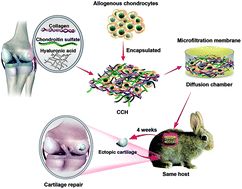Therapy for cartilage defects: functional ectopic cartilage constructed by cartilage-simulating collagen, chondroitin sulfate and hyaluronic acid (CCH) hybrid hydrogel with allogeneic chondrocytes
Abstract
Objective: To regenerate functional cartilage-mimicking ectopic cartilage as a source for the restoration of cartilage defects, we used a previously synthesized three-phase collagen, chondroitin sulfate and hyaluronic acid (CCH) hydrogel for the encapsulation of allogeneic chondrocytes with a diffusion chamber system that was buried subcutaneously in the host for 4 weeks and then implanted into a cartilage defect. Methods: The CCH hydrogel was prepared and seeded with allogeneic chondrocytes from new-born rabbits, prior to being enveloped in a diffusion chamber that prevents cell ingrowth and vascular invasion of the host, as described previously. A collagen hydrogel (C) was used as the control. The diffusion chamber was embedded subcutaneously in an adult rabbit. 4 weeks later, the regenerated tissue was harvested from the diffusion chamber and then further used for cartilage repair in the same host. To evaluate the regenerated tissue, cell viability assay using calcein-acetoxymethyl (calcein-AM)/propidium iodide (PI) staining, biochemical analysis by examination of total DNA and GAG content, gene expression detection using RT-PCR for Col 1a1, Col 2a1, Acan, and Sox9, biomechanical detection and histological evaluation were implemented. Results: Analysis of the cell activity and biochemical evaluation in vitro showed that cell proliferation, GAG secretion and gene/protein expression of cartilage specific markers were much higher in the CCH group than those in the C group. The CCH constructed ectopic cartilage tissue in vivo showed the typical characteristics of hyaline cartilage with higher expression of cartilage matrix markers compared with the C groups, as evidenced by morphological and histological findings as well as RT-PCR analysis. Furthermore, ectopic cartilage from CCH successfully facilitated the cartilage restoration, with higher morphological and histological scores and greater mechanical strength than that from C. Conclusion: The three-phase CCH hydrogel, which is closer to natural cartilage matrix and is stiffer than collagen, may replace collagen as the “gold standard” for cartilage tissue engineering. This study may provide a new insight for cartilage repair using ectopic cartilage reconstructed from functional materials and allogeneic cells.



 Please wait while we load your content...
Please wait while we load your content...